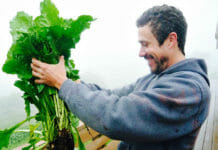 Hey, did you know it is National Farmers Market Week?
Hey, did you know it is National Farmers Market Week?
US Secretary of Agriculture Tom Vilsack proclaimed August 5-11, 2012 as National Farmers Market Week. Since 2000, the number of recorded farmers markets has grown over 170%, from 2,863 markets in 2000 to more than 7,800 in 2012. Bucks County now has eight farmers markets, as well as many farm stand and a few year round farm stores. As demand grows for fresh local food, and shoppers seek relationships with the farms that make such food possible, farmers markets represent an important retail option that bolster local economies in communities large and small. Here’s some interesting statistics:
- Boise, Idaho’s Capital City Public Market generated an estimated $4.5 million in economic activity for the local economy in 2011.
- A Virginia Cooperative Extension report showed if households in Southern Virginia spent 15 percent of their weekly food budget on locally grown food products, $90 million in new farm income would be created for the region.
- A 2010 study by USDA’s Economic Research Service compares producers selling salad mix, blueberries, milk, beef and apples locally with producers of the same products selling to mainstream supply chains. “In all five cases, nearly all of the wage and proprietor income earned in the local market chains is retained in the local economy”.
- In Iowa, thanks to the efforts of the Northeast Iowa Food and Fitness Initiative, sales of local food by farmers in northeast Iowa rose from less than $10,000 in 2006 to over $2 million by 2010. It is estimated that the increase has brought 26 new jobs to the area.
- A series of case studies by Civic Economics shows that for every dollar we spend at a large chain, about 15 cents stays in the area, while locally owned enterprises like farms trap 30 to 45 cents.
- Twenty-six Mississippi farmers markets created a total economic impact of $1.6 million, 15.88 part-time jobs, $213,720 in wages, and $16,000 in state and local taxes.
Research shows, too, that farmers markets spur spending at neighboring businesses. A 2010 study of the Easton Farmers Market in Pennsylvania, for example, found that 70% of farmers market customers are also shopping at downtown businesses, spending up to an extra $26,000 each week.
A 2011 Economic Research Service report found that fruit and vegetable farms selling into local and regional markets employ 13 full-time workers per $1 million in revenue earned, for a total of 61,000 jobs in 2008. Comparatively, fruit and vegetable farms that are not selling locally employed only 3 full-time workers per $1 million in revenue.
“Farmers markets are the ultimate green sector of the economy,” says Bernadine Prince, President of the Farmers Market Coalition. “They are stand-out successes in and spurring sustainable economic development. During Farmers Market Week, FMC encourages everyone to spend at least $10 at a local farmers market, and celebrate the power of farmers markets to incubate entrepreneurship and nourish both rural and urban economies.”
For a list of local Bucks County farmers’ markets click here.
Seven Days, Seven Ways to Celebrate Farmers Market Impacts
- Sunday, August 5th: Farmers markets and community education
Innovative partnerships that allow markets to serve as hubs of information - Monday, August 6th: Farmers markets and public health
Promoting good nutrition and healthful habits - Tuesday, August 7th: Farmers markets as economic engines
Business incubation, job development, and local spending - Wednesday, August 8th: Farmers at the center of the system
Governance and policies that put farmers first - Thursday, August 9th: Farmers markets and food equity
Improving access to healthful foods in under-served neighborhoods - Friday, August 10th: Farmers markets and civic engagement
Growing social capital and engaging volunteers - Saturday, August 11th: Farmers markets and rural renewal
Supporting agricultural diversity and farm viability, while inspiring a new generation of producers
Thanks to the Farmers Market Coalition for this information.










![What we’re reading [Oct 16 2017]](https://www.buckscountytaste.com/wp-content/uploads/2017/10/coffee_macbook_reading_pexels-photo-414630-218x150.jpeg)

[…] National Farmers Market Week […]